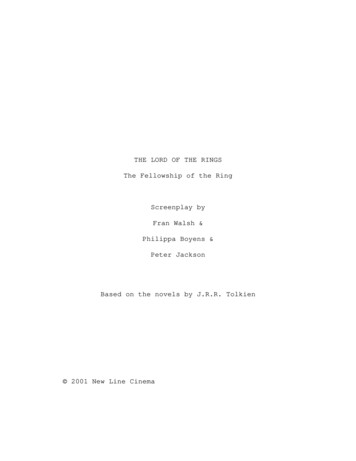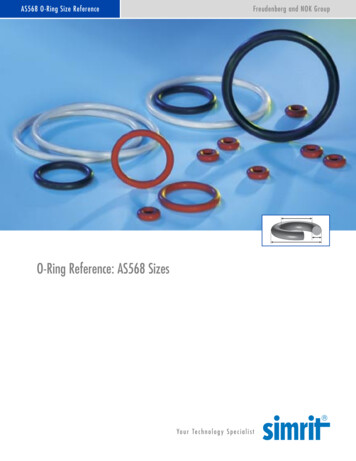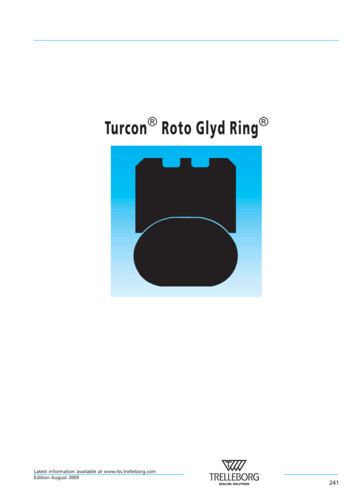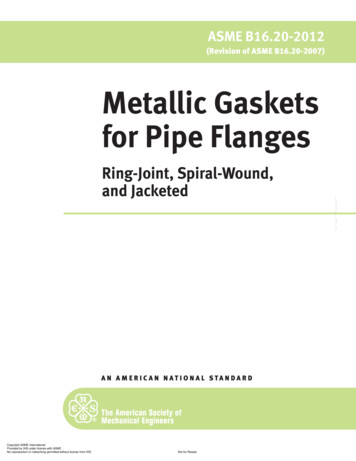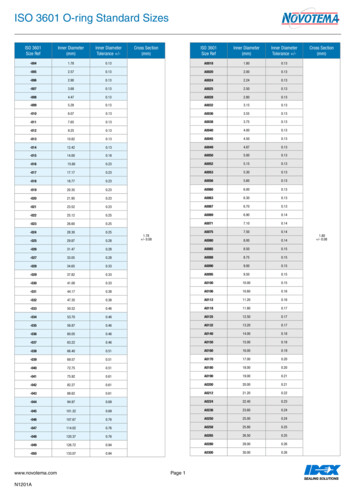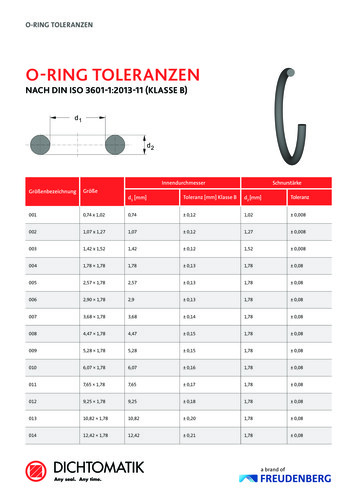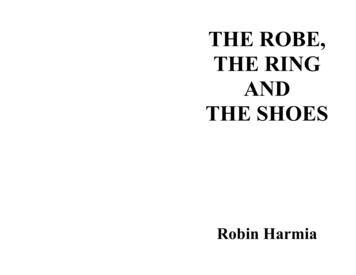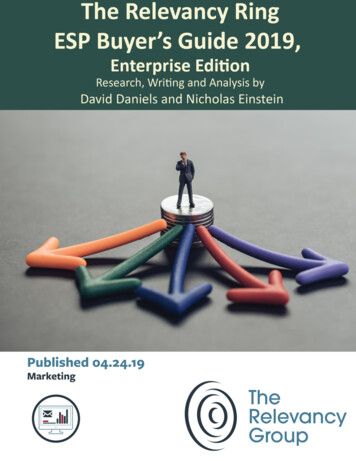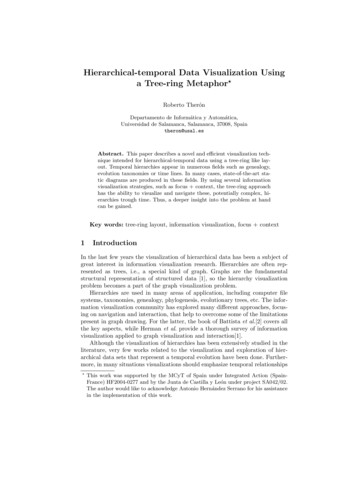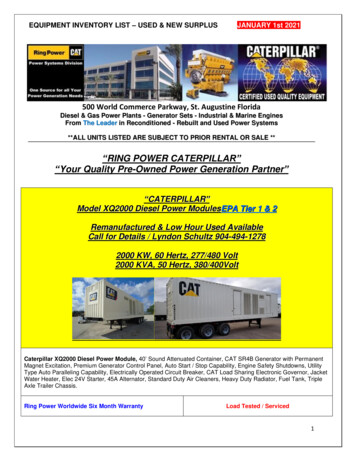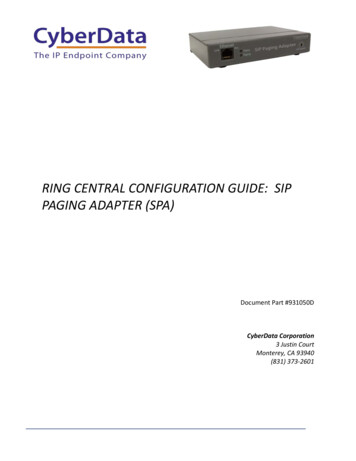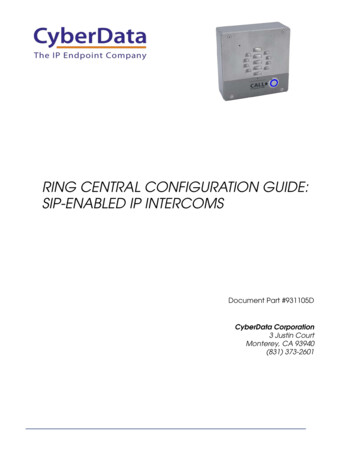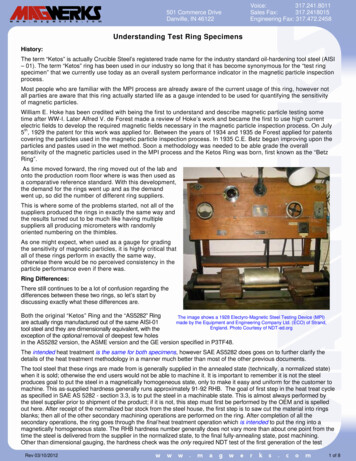
Transcription
501 Commerce DriveDanville, IN 46122Voice:317.241.8011Sales Fax:317.2418015Engineering Fax: 317.472.2458Understanding Test Ring SpecimensHistory:The term “Ketos” is actually Crucible Steel’s registered trade name for the industry standard oil-hardening tool steel (AISI– 01). The term “Ketos” ring has been used in our industry so long that it has become synonymous for the “test ringspecimen” that we currently use today as an overall system performance indicator in the magnetic particle inspectionprocess.Most people who are familiar with the MPI process are already aware of the current usage of this ring, however notall parties are aware that this ring actually started life as a gauge intended to be used for quantifying the sensitivityof magnetic particles.William E. Hoke has been credited with being the first to understand and describe magnetic particle testing sometime after WW-I. Later Alfred V. de Forest made a review of Hoke’s work and became the first to use high currentelectric fields to develop the required magnetic fields necessary in the magnetic particle inspection process. On July5th, 1929 the patent for this work was applied for. Between the years of 1934 and 1935 de Forest applied for patentscovering the particles used in the magnetic particle inspection process. In 1935 C.E. Betz began improving upon theparticles and pastes used in the wet method. Soon a methodology was needed to be able grade the overallsensitivity of the magnetic particles used in the MPI process and the Ketos Ring was born, first known as the “BetzRing”.As time moved forward, the ring moved out of the lab andonto the production room floor where is was then used asa comparative reference standard. With this development,the demand for the rings went up and as the demandwent up, so did the number of different ring suppliers.This is where some of the problems started, not all of thesuppliers produced the rings in exactly the same way andthe results turned out to be much like having multiplesuppliers all producing micrometers with randomlyoriented numbering on the thimbles.As one might expect, when used as a gauge for gradingthe sensitivity of magnetic particles, it is highly critical thatall of these rings perform in exactly the same way,otherwise there would be no perceived consistency in theparticle performance even if there was.Ring Differences:There still continues to be a lot of confusion regarding thedifferences between these two rings, so let’s start bydiscussing exactly what these differences are.Both the original “Ketos” Ring and the “AS5282” RingThe image shows a 1928 Electyro-Magnetic Steel Testing Device (MPI)made by the Equipment and Engineering Company Ltd. (ECO) of Strand,are actually rings manufactured out of the same AISI-01England. Photo Courtesy of NDT-ed.orgtool steel and they are dimensionally equivalent, with theexception of the optional removal of deepest few holesin the AS5282 version, the ASME version and the GE version specified in P3TF48.The intended heat treatment is the same for both specimens, however SAE AS5282 does goes on to further clarify thedetails of the heat treatment methodology in a manner much better than most of the other previous documents.The tool steel that these rings are made from is generally supplied in the annealed state (technically, a normalized state)when it is sold; otherwise the end users would not be able to machine it. It is important to remember it is not the steelproduces goal to put the steel in a magnetically homogeneous state, only to make it easy and uniform for the customer tomachine. This as-supplied hardness generally runs approximately 91-92 RHB. The goal of first step in the heat treat cycleas specified in SAE AS 5282 - section 3.3, is to put the steel in a machinable state. This is almost always performed bythe steel supplier prior to shipment of the product; if it is not, this step must first be performed by the OEM and is spelledout here. After receipt of the normalized bar stock from the steel house, the first step is to saw cut the material into ringsblanks; then all of the other secondary machining operations are performed on the ring. After completion of all thesecondary operations, the ring goes through the final heat treatment operation which is intended to put the ring into amagnetically homogeneous state. The RHB hardness number generally does not vary more than about one point from thetime the steel is delivered from the supplier in the normalized state, to the final fully-annealing state, post machining.Other than dimensional gauging, the hardness check was the only required NDT test of the first generation of the testRev 03/10/20121 of 8
501 Commerce DriveDanville, IN 46122Voice:317.241.8011Sales Fax:317.2418015Engineering Fax: 317.472.2458rings (Ketos Rings). Since the hardness value does not change much (generally 1 point), the customer can not easilydetect if this required final annealing operation had ever been performed.This final full-anneal operation is detailed in SAE AS 5282 section 3.4. This portion of the required heat treatment isessentially no different than it was approximately 60 years ago; the verbiage has just been clarified a bit in the AS spec soas to eliminate as much confusion as possible. The time and temperature requirements are actually based off of the steelmanufacturer’s recommendations for this alloy; this is true for both versions of rings. Slight variations in the time andtemperature values can be seen between Crucible Steel’s recommendations for annealing and the listed NDT specsbelow, however these differences are no more than what can be found between the different brands of O-1 tool steelmanufacturers. The requirements listed in the NDT specs do tend to be a bit more conservative comparatively.Specification Differences:Now the “reasons for being” on the “new” 13-year old AS spec:SAE AS-5282 came into existence as a corrective action to combat the tremendous variations in the performance of ringsbeing produced and sold over the past 60 years or so. Unfortunately, these variations were further amplified when ASTME1444-94a changed the requirement for the most critical final heat treatment from a shall , to a may condition. The nextrevision which was ASTM E1444-01, actually eliminated the final heat treat requirement altogether. Elimination of that step didsave the ring manufacturers money however, the final result of this action spoke for itself.Previous to the introduction of AS5282 there was no “magnetic” qualification test requirement on any ring to insure that itwas in fact produced in a magnetically homogeneous state. Two of the main goals of AS5282 were, 1. introduce amethodology to magnetically qualify and quantify the test ring and, 2. make the ring individually traceable to the plottedresults. The shortcomings in ASTM E1444 were never addressed by SAE.In any magnetically homogeneous material one should expect to see a direct relationship between the field strength and themeasurement distance; in this case it would be the increasing distance from the outer periphery to the holes. The inversesquare would result in air when doubling the distance and in any magnetically homogeneous material, one should expectsomething approaching this same relationship. On a good ring, regardless of the version, the results should show thistype relationship when mapped. For examples of this see illustrations 1 & 2.With a qualified magnetizing power supply (not an MPI machine) and proper magnetic data logging equipment anindividualized field leakage plot of the ring may be obtained in order to quantify and qualify this variable for the finished ring.Usage Notes:Oddly enough, people still get confused over the proper use of the Ketos test ring, so the next few paragraphs have beenadded to help add clarification.In short, this ring is generally considered a quick and easy “gauge” to determine the machine’s overall system conditionprior to inspection of parts. This is to be used as one of the daily systems tests which are to be logged for each machinein use. So with this being said, one is using the ring to check the system, not the system to check the ring. “Certifying”the test ring with a mag machine is working backwards and although this may seem obvious, it is still done.As most people are already aware, either version of the test ring is intended to be used on machines with a DC outputwaveform. That could be either HWDC or FWDC, in a single-phase configuration, or in a three-phase configuration. Anyone of these DC waveforms should give similar, but not exactly the same results on the test ring, assuming the ammetersare properly scaled and calibrated. Due to the pulsating nature of the HWDC waveform, HW generally has a tendency toshow more lines that FW does at a particular given amperage. It is also interesting to note that not all ammeters whichclaim to be scaled to properly read HWDC actually are; this can be another major source of consternation when using thetest ring.With all of this being said, the number of lines you get on a qualified AS5282 Ring, or Ketos ring should not be a variableof the ring itself, but some other combination of the variables of the entire inspection system. If one has a good ring and theyare having problems developing an adequate number of lines at a given amperage, it would indicate some type ofproblem within the system which would need to be corrected prior to performing any actual inspection work. However,when problems do come up, it is always good practice to look at the ring’s pedigree; any ring without an individualserialized field plot should be suspect right away. Make sure you have a gauge prior to trying to perform a measurement,without one it simply cannot be done.There are many system variables which can affect how many lines one might see on the ring, but once you have a knowngood standard, you can then make meaningful tests.Rev 03/10/20122 of 8
501 Commerce DriveDanville, IN 46122Voice:317.241.8011Sales Fax:317.2418015Engineering Fax: 317.472.2458General Notes on Annealing and Normalizing:The main difference between full annealing and normalizing is that fully annealed parts are uniform in softness (andmachinablilty) throughout the entire part; since the entire part is exposed to the controlled furnace cooling. In the case ofthe normalized part, depending on the part geometry, the cooling is non-uniform resulting in non-uniform materialproperties across the part. This may not be desirable if further machining is desired, since it makes the machining jobsomewhat unpredictable. In such a case it is better to do full annealing.Read more: http://wiki.answers.com/Q/What is difference between annealing and normalizing#ixzz1HSWRoS18NOTE: Some of the NDT documents reviewed use the word may and should instead of the correct word shall for the finalannealing cycle. SHALL was the intended operation to have been performed on all of these rings.This deviation from the original intent of the documents could have been a typo in E1444-94a which then was copied fromdocument-to-document, just like the words “ANSI 0-I Tool Steel”, instead of the correct AISI O-1 Tool Steel, but reviewingthe history of changes, it appears that this was an intended change at the time, probably because of the lack ofunderstanding for the reason behind the final annealing step.It is interesting to note that the GE document did maintain the correct word shall, however the typo of “ANSI” was notcorrected; this typo is the same as in ASTM E1444-91 through E1444-05 and ASME Sec V. Additionally, ASME listed twodifferent annealing methods within the same document without the accompanying reasoning for the discrepancy.Annealing Verbiage Contained within the Steel Makers SpecificationsVerbiage from Crucible Steel’s Tool-Steel HandbookKETOS Steel (AISI O1 Steel)Annealing*Full Anneal1. Heat to 1400/1440 F. hold for 2 hours.2. Cool slowly at a maximum rate of 50 F per hour to below 1200 F.3. Air CoolVerbiage from Cincinnati Tool Steel CompanyAISI O1 SteelAnnealingThe recommended annealing practice is to use controlled-atmosphere furnaces. If these are not available, pack-anneal inan inert material. For a quick annealing cycle to develop fair machining properties, heat slowly to 1375 to 1425 F. andcool slowly in the furnace. *To develop the lowest hardness and best spheroidization for optimum machinability, heatslowly to 1450 F. and furnace cool at 20 degrees per hour to 900 F. The piece may then be removed from the furnaceand cooled in air. Hardness after this cycle will be Brinell 202 max.*Full Anneal1. Heat to 1450 F. (no mention of soak time)2. Cool slowly at a maximum rate of 20 F per hour to below 900 F.3. Air CoolRev 03/10/20123 of 8
501 Commerce DriveDanville, IN 46122Voice:317.241.8011Sales Fax:317.2418015Engineering Fax: 317.472.2458Chronology of Related Specifications:Changes in MIL Documents over the decades:MIL-M-11472 – 24 Nov 1952, makes no mention of test rings specimens at all.MIL-M-6867C – 27 Jan 1969, makes no mention of test rings specimens at all.MIL-I-6868E – 8 March 1976, references the “Ring Specimen” however gives no data for heat treat or alloy.MIL-STD 1949 – 1 Aug 1985, uses the correct acronym for the steel alloy and uses the word shall in the annealingrequirements, however it does not go on further to state the specific annealing methodologywithin the document.Changes in ASTM E1444 over the decades:ASTM E1444-91 – 15 Nov 1991, uses the incorrect acronym for the steel alloy and uses the word shall in the annealingrequirements, and it does go on further to state the specific annealing methodology within the document.ASTM E1444-94a – 15 Nov 1994, uses the incorrect acronym for the steel alloy and uses the word may in the heat treatsection. No reference to AS5282 Ring introduced yet.ASTM E1444-01 – 10 Feb 2001, uses the incorrect acronym for the steel and the heat treat section has now beencompletely eliminated
Photo Courtesy of NDT-ed.org Understanding Test Ring Specimens History: The term “Ketos” is actually Crucible Steel’s registered trade name for the industry standard oil-hardening tool steel (AISI – 01). The term “Ketos” ring has been used in our industry so long that it has become synonymous for the “test ring specimen” that we currently use today as an overall system .
